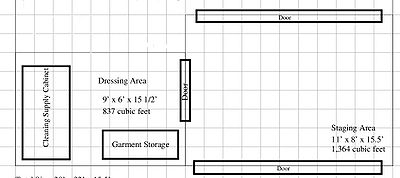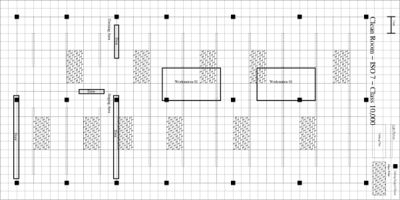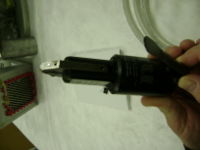Difference between revisions of "CLAS12 R1"
| Line 171: | Line 171: | ||
[[Image:Air_Actuated_R1_CrimpingTool.jpg | 200 px]] | [[Image:Air_Actuated_R1_CrimpingTool.jpg | 200 px]] | ||
| + | |||
| + | |||
| + | =CLAS12_R1_Progress_Reports= | ||
| + | [[CLAS12_R1_Progress_Reports]] | ||
[[CLAS12_R1_Prototype_2-20-08]] | [[CLAS12_R1_Prototype_2-20-08]] | ||
Revision as of 14:50, 3 September 2009
Time line
The timeline below needs to be updated
| Start Date | End Date | Description |
| 3/12/2010 | 11/12/2010 | Build R1 stringer fixtures |
| 12/8/09 | 3/11/2010 | Procure Clean room Fixtures and Equipment |
| 5/8/09 | Clean Room Setup | |
| 6/8/09 | Wire tension apparatus in place | |
| 12/17/2010 | 9/30/2011 | String R1 Chambers |
ISU Clean Room Facility
--- 6/18/09 ---
The clean room needs space for instrumenting. The DC will be layed horizontal so PC cards can be mounted and tested.
No Halogen lighting.
Think about air conditioning. People are space heaters.
Have shoes specific for clean room instead of booties.
Electron microscope may need to be used to inspect wire quality. Peel off 3 feet off each spool , mount 6 wire samples on holder, look at wire with microscope measure diameter. Can ISU do this testing?
Below is a preliminary schematic of the floor design of ISU's clean room that will be built at the IAC.
The dimensions of the clean room itself will be:
15.5' high 24' deep 20' wide
The doors into and out of the different areas will be 9'8" high in order to help facilitate the transport of equipment into and out of the different areas of the clean room.
The desks in the clean room will act as a table top area to place tools and other equipment currently in use during the construction of the wire chambers. Also, they will serve as a place to perform any calculations or other miscellaneous work that may come up while construction is ongoing.
The cabinets on the other side of the room will be a permanent storage area for all tools and equipment not currently in use at the two work stations.
The path in between the workstations and the cabinets will be kept clear of all obstructions in order facilitate the movement of equipment into and out of the room as needed.
The two workstations will be where the wire chambers are constructed. The workstations will have a standing/sitting apparatus built around them in order to help those who are stringing the wire chambers to have better access to the chambers from above. Schematics for these will be uploaded as they are designed.
The heavy equipment storage area will be where all the heavier equipment (i.e. dollies, fabrication materials, etc...) that will not fit, or does not need to be stored in the individual work station cabinets will be kept.
Staging & Dressing Area
Attached to the clean room, and also kept in a class 10,000 environment, will be the staging area that will be used to transport the wire chambers and other materials into and out of the clean room environment, and will also help facilitate entrance into the dressing and prep area that people will use before entering the clean room itself.
Staging Area Dressing Area 15.5' high 15.5' high 08' deep 06' deep 11' wide 09' wide
The dressing area will be where the cleaning supply cabinet will be kept. This is because when cleaning the clean room one will start at the back and work their way forward. This is to prevent cross contamination in the cleaning process from a person treading upon previously cleaned area.
Inside the cleaning supply cabinet will be where the cleaning chemicals and other supplies are stored for cleaning of the clean room. A list of supplies and cleaning schedule will be uploaded in the near future.
Ceiling Support, HEPA Filters, & Lighting
The clean room will be suspended from ceiling at the supports shown above. The ceiling tiles will fit snugly, but will be removable if need be so that an overhead crane can be lowered into the room to pick up and move heavy equipment if need be.
The HEPA filters will cover roughly ~10-12% of the ceiling in order to maintain a Class 10,000 environment. The filters will move approximately 35-40 air volumes per hour.
Overhead lighting will be suspended from the frame in order to provide sufficient lighting for the room occupants to work within.
HEPA Filters
Due to the cost of HEPA filters, a multistage filtration system will be used with the HEPA filters at the end of the system in order to insure the longevity of the HEPA filters.
More information will be forthcoming on this in the future.
ODU's Clean Room
ODU's current clean room size:
high deep wide
CLAS 10,00 clean rooms
Environmental control needed
Temperature control constraint is
The wire tension can fluctuate no more than 5% from the mean wire tension specification.
This means that the temperature should be controlled to within +/- 2 Degrees Ferenheit
Humidity control: 55 % or less
Cleaning Procedures
R1 Construction preparations
Wire Tension
A Helmholtz coil is used to test the wire tension
An excel spreadsheet to calculate fields for such coils is given at
http://clasweb.jlab.org/drawings/CLAS12/DRIFT_CHAMBERS/Helmholz_calculator.xls
The formula is from Physics 10X but more importantly it contains wire parameters useful for the calculation
Discussion items
1.) Budget
- JLab to ISU travel for JLab personnel to inspect operations
- shipping container for R1 chambers
2.) Clean room
cost =
assume we copy the ODU clean room
Using IAC conference room space, need to remove carpet and paint floor.
3.) hiring timeline
9/08 NSF proposal submission
4.) stringing platform and DC stringing support arm
5.) Manpower
6.) MOU to support post doc request or faculty release time
7.) Stringing equipment
a.) crimping tool
b.) glue
c.) wire or feedthroughs?
d.) wire tension measurement (PC, Magnets, associated electronics
A few pictures ff the R1 fullo size proto type from my JLab visit on 9/16/07. It is about 6 feet tall. CLAS12_R1_Prototype_9-16-07
The air actuated crimping tool:


